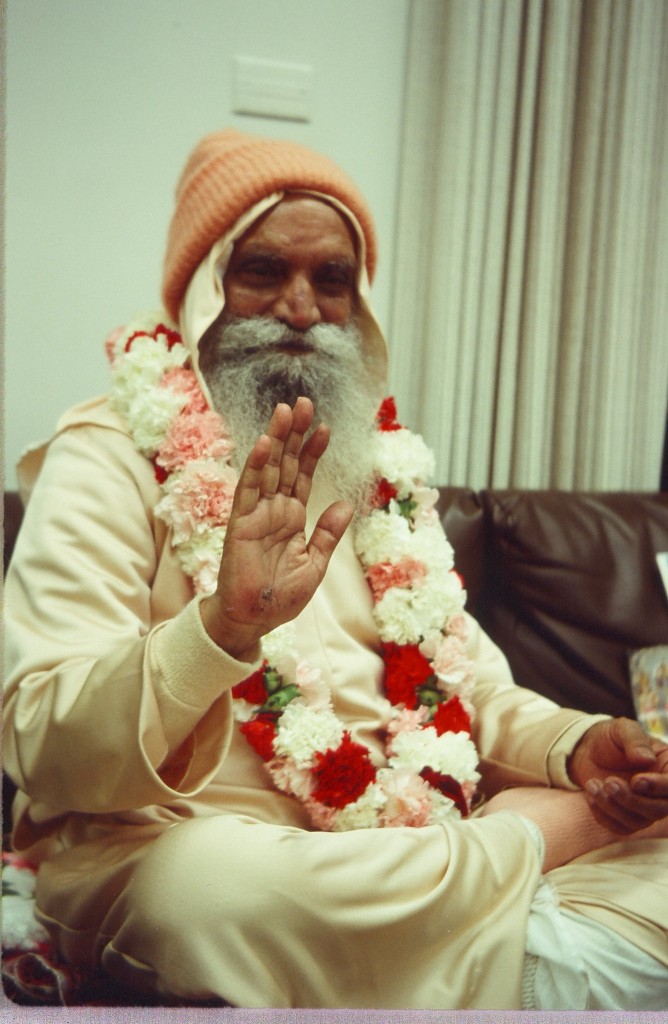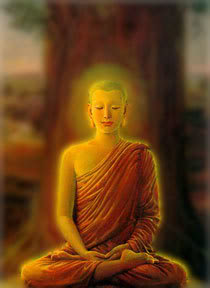Happiness
From Mata Amritanandamayi to Amma Shri Karunamayi ~ Ron’s Memoirs
“… if someone is supposed to propagate the Dharma and their behavior is harmful, it is our responsibility to criticize this with a good motivation. This is constructive criticism, and you do not need to feel uncomfortable doing it. In “The Twenty Verses on the Bodhisattvas’ Vows,” it says that there is no fault in whatever action you engage in with pure motivation. Buddhist teachers who abuse sex, power, money, alcohol, or drugs, and who, when faced with legitimate complaints from their own students, do not correct their behavior, should be criticized openly and by name. This may embarrass them and cause them to regret and stop their abusive behavior. Exposing the negative allows space for the positive side to increase. When publicizing such misconduct, it should be made clear that such teachers have disregarded the Buddha’s advice. However, when making public the ethical misconduct of a Buddhist teacher, it is only fair to mention their good qualities as well.”
~ Dalai Lama, Ethics in the Teacher-Student Relationship, 1993
“Can a guru who displays jealousy and competition toward other spiritual leaders help seekers? Such behavior shows that the personality aspects, each with its own ego, are still in control.”
~ Swami Sivananda Radha, “In The Company of The Wise”, page 190
“Do not believe in anything simply because you have heard it.
Do not believe in anything simply because it is spoken and rumored by many.
Do not believe in anything simply because it is found written in your religious books.
Do not believe in anything merely on the authority of your teachers and elders.
Do not believe in traditions because they have been handed down for many generations.
But after observation and analysis, when you find that anything agrees with reason and is conducive to the good and benefit of one and all,
then accept it and live up to it.”
~ Buddha

Shri Amma Karunamayi
Introduction.
After Guruji returned to India in 1980, I met and learned from many other teachers. Beginning in 1987, I was especially attracted to the devotional path of Amritanandamayi (Ammachi) of calling and crying to the Divine, and for seven years I attended many of her US darshans and regular programs at her San Ramon ashram. (See https://sillysutras.com/other-teachers-mata-amritanandamayi-ammachi-rons-memoirs/)
But while drawn to Ammachi’s devotional path, I continued meeting other spiritual teachers. Through my interest in Ammachi, I met Shri Vijayeshwari Devi another memorable Indian female teacher known as Amma Shri Karunamayi who like Ammachi is revered by some devotees as an avatar or embodiment of divine mother. I met Karunamayi under surprising circumstances which ended my relationship with Ammachi and sparked an important new transformative life phase of increasing reliance on inner rather than outer authority. (see e.g. my essay “I’ve Found A Faith-Based Life”)
Learning of Amma Shri Karunamayi.
In 1995, my trusted friend Richard Schiffman – a talented spiritual poet, author and mainstream journalist – who I had met at an Ammachi program in New Mexico after he had lived many years in India – told me by phone that Amma Shri Karunamayi a female Indian spiritual teacher considered a Divine Mother avatar had recently visited New York and other US areas for the first time. He said that many Ammachi New York devotees had been greatly impressed by Karunamayi, and that some wanted to help her organize future US tours. From Richard’s description of Karunamayi, I felt a strong desire to see her, so I asked Richard to keep me informed of her schedule.
Synchronistically, just after Richard told me about Karunamayi, I received two letters from friends in India, telling how they had just spent a month with Karunamayi in Bangalore. They said she is “quite special [and] incredibly gentle and soft and radiates a beautiful and loving presence”, and that “many miraculous stories [are] attributed to her”. They recounted some of those stories, and reported that because Karunamayi was college educated with a focus on meditation (and not hugging) she attracted some more sophisticated devotees than the devotionally adoring people often attracted to Ammachi.
In March 1996, I again received a synchronistic phone call concerning Karunamayi, this time from another spiritual friend, who – like Richard and my friends in India – was also an Ammachi follower. Until then I was unaware that she knew of Karunamayi. So I was quite surprised when my friend asked if I could suggest some Bay Area place where Karunamayi and her entourage could stay in a few months during their first Bay Area visit. Only then did my friend disclose that she had met Karunamayi in Seattle in 1995 where she had offered to host Karunamayi’s first Bay Area visit in 1996.
Also, my friend credibly explained that Ammachi’s New York devotees had received an ‘edict’ from Ammachi – which I later confirmed – against helping or seeing Karunamayi; that she had changed her mind about hosting Karunamayi based on “personal considerations”, and because she felt disharmony with Karunamayi’s national organizers who were aggressively putting undue time pressure on her.
With compassion for my friend’s dilemma, and motivated by a sense of injustice about Ammachi’s ‘edict’ against Karunamayi, I offered to make inquiries about possible San Francisco places where Karunamayi’s entourage could reside and give public programs. But, I explained that since I was living a reclusive life in a small apartment I could not offer to personally host Karunamayi’s large entourage.
Thereupon, my friend called the national organizers for Karunamayi, “resigned” as Bay Area sponsor, and gave them my phone number as a San Francisco contact who might look for appropriate venues. Without consulting me, the Karunamayi national organizers then “conscripted” my services by distributing national flyers with my phone number as their San Francisco organizer.
Despite my displeasure with that involuntary “conscription” as a Karunamayi organizer, I did not – like my friend – tell the national organizers to ‘take me out of the loop’. My sense of compassion and justice inhibited me from leaving Karunamayi without help in the Bay Area. So I decided to help Karunamayi while seeking others who would replace me as Bay Area organizer. Thereupon my daily regime of solitary meditation and prayer and walking in Nature was significantly changed as I made and received phone calls, wrote letters and inspected possible darshan halls.
Though I never located a replacement Karunamayi sponsor, I found several friends who agreed to help. A recently widowed friend who lived alone in a very large Presidio Heights residence agreed to house Karunamayi’s entourage, and to allow morning public gatherings there. Another friend agreed to answer all telephone inquiries about Karunamayi’s schedule. And my dear friend Bina Chaudhuri – widow of Dr. Haridas Chaudhuri, with whom she had co-founded the California Institute of Integral Studies (CIIS) and the Cultural Integration Fellowship (CIF) – arranged for Karunamayi’s evening programs to be held in the lovely CIF main hall.
Meeting Karunamayi.
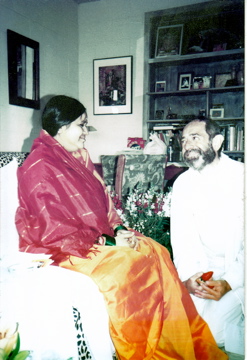
Ron with Karunamayi
As Karunamayi’s first San Francisco sponsor, I was privileged to have various private discussions with her. I learned that like Ammachi Shri Vijayeshwari Devi had no lineage or guru, but that her mother had been a devotee of Shri Ramana Maharshi, who was told by Ramana when pregnant that she would give birth to Devi [“the Mother”]. Just short of college graduation, Karunamayi had retreated to a remote forest where she spent ten years in solitary rigorous practice. Like Guruji, and consistent with her extraordinary early sadhana, Karunamayi’s emphasis was on meditation. Her presence evoked for me moods more meditative than devotional, and inspired my poetry about silence. (see e.g. https://sillysutras.com/in-silence-sweet/) Like Guruji she apparently perceived my subtle auric field. Most memorably she once told me that: “Dhyanyogi has greatly helped you in ways you can not yet know.”
She did not insist that devotees have only one guru.
Once as I was driving Karunamayi and Swami Vijashwarananda – her cousin and Telugu/English interpreter – to the beautiful Marin County Vedanta retreat center, the Swami asked: “Mother wants to know what you eat?” In response I told him: “I eat mainly raw fruits and vegetables, nuts and seeds, and rice and beans.” Whereupon the Swami interpreted my words for Karunamayi, who laughed and replied in Telugu. Then Swami said to me: ”Mother says you’ve eaten like that for many lifetimes.”
Unlike Ammachi, Karunamayi repeatedly encouraged devotees to seek company of other spiritual teachers, as well as to meditate regularly.
The “last straw” with Ammachi.
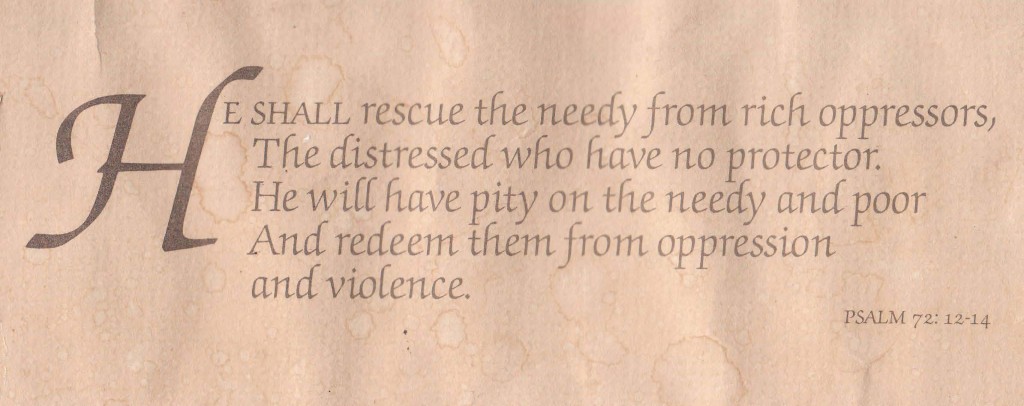
All my helper friends – like me – were Ammachi followers, but none of us felt conflict with Ammachi since Karunamayi’s San Francisco visit was scheduled for August when Ammachi would not be here. Though my sense of fairness was severely shaken by Ammachi’s New York ‘edict’ against Karunamayi, for a while I suppressed those feelings, along with my long suppressed concerns about a commercialized cult of personality around Ammachi, and the Mother Meera book burning incident. So at first that edict did not quite become “the last straw” in ending my faith in Ammachi.
That happened only after I learned of defamatory gossip and rumors about Karunamayi attributable to the Ammachi organization. Especially after I had met and was blessed by Karunamayi, and was experientially convinced of her authenticity as a spiritual master, I became deeply offended by these false and scandalous rumors, and motivated to help her as an ‘anti-defamation’ attorney.
For many years one of my daily Hindu practices from Guruji was recitation of the Hanuman Chalisa – a poetic ode to the legendary monkey-god Hanuman by poet-saint and philosopher Tulsidas. Though when I met Karunamayi my daily Chalisa practice had lapsed, Karunamayi saw the Hanuman Chalisa in my subtle field and, during a ceremony atop sacred Mount Tamalpais in Marin County, she spontaneously asked me to recite it as part of the ceremony.
Serendipitously, I had just received by mail from my friends in India a beautiful printed version of the Hanuman Chalisa. In a letter to them acknowledging that gift, I wrote:
“Slanderous rumors about Karunamayi originating at the ‘Kerala cuckoo compound’ have strongly activated my justice vasanas [propensities].” — so I wish to — “help as Her self-appointed anti-defamation lawyer. The Chalisa venerates Hanumanji as ‘the protector of saints and sages’, and after many years of recitations, I’ve assimilated some of that energy.”
So, despite my gratitude for the many devotional blessings I had received in Ammachi’s presence, after several years of growing but suppressed concerns about an ‘adulation of the incarnate’ rather than ‘adoration of the Infinite’ atmosphere around her, and about my diminished energy at her satsangs, my realization of Ammachi’s apparent jealousy and competition toward Karunamayi, Mother Meera and other teachers proved “the last straw” in my relationship with her.
Moreover, this realization traumatically brought to my consciousness the long-suppressed awareness that naively and mistakenly I had been projecting perfection onto Ammachi, rather than seeing her as a limited human being; that in adulating Ammachi I was misperceiving my own best qualities. This sudden ‘perfection projection realization’ triggered an important new transformative life phase of increasing reliance on inner rather than outer authority, which I will recount in other memoirs chapters.
(*see footnote)
Epilogue.
For many years I have been reluctant to publicly share my disaffection with Ammachi and her organization. I did not wish to discourage other devotees with different perspectives, some of whom are friends. But I now feel morally impelled to share my observations which support credibility of a recently published critical book about Ammachi, by Gail Tredwell (aka “Gayatri” or “Swamini Amritaprana”), who for twenty years was Ammachi’s revered personal attendant, and first and closest Western female devotee. Her memoir entitled “Holy Hell, A Memoir of Faith, Devotion and Pure Madness” contains many shocking but credible revelations, including reference to Ammachi’s ‘edict’ against Karunamayi (at pages 264-266).
Unable truthfully to attack the credibility of Gail’s memoir about Ammachi, the MA Centers organization has attacked Gail’s character by asserting that she is “a troubled individual” whose writings are “completely untrue and without a basis in fact or reality”, and by instigating and publishing false and defamatory rumors and on-line blog posts about her, while asserting meritless libel claims to intimidate others against commenting on or republishing Gail’s sincere perspectives.
Since I am quite convinced that Gail’s memoirs are true and sincere, I find deeply disrespectful and offensive such an ad hominem attack on her by those to whom she selflessly dedicated much of her adult life. Just as I felt impelled to assist Karunamayi against defamatory rumors, I now feel dharmically impelled to support Gail’s credibility.
Footnote.
* In further memoirs I will tell how – like some other Westerners without any guru tradition – I was naive about Ammachi and other limited or flawed Eastern teachers onto whom I mistakenly projected purported perfection and infallibility, rather than seeing them as limited humans though perhaps further evolved in spiritual awareness. And, I will recount how while faithfully revering my beloved Guruji, and while remaining grateful for blessings received from all my spiritual teachers – including Ammachi – I more and more began relying on inner rather than outer authority; and how whimsically I told friends that I had been transformed from “Born-again Hindu” to “Uncertain Undo”; from Gurubhai to ‘Guru bye bye’.
To karmically repay those few teachers I’ve forsaken in this life, in my next incarnation I may become an insurance underwriter/salesman specializing in custom coverage for spiritual teachers called: “Perfection projection protection”.
Dalai Lama – Many Faiths, One Truth
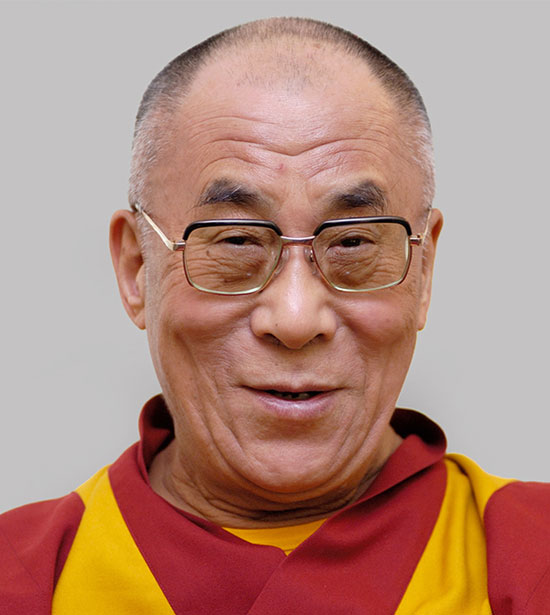
Many Faiths, One Truth
By Tenzin Gyatso
WHEN I was a boy in Tibet, I felt that my own Buddhist religion must be the best — and that other faiths were somehow inferior. Now I see how naïve I was, and how dangerous the extremes of religious intolerance can be today.
Though intolerance may be as old as religion itself, we still see vigorous signs of its virulence. In Europe, there are intense debates about newcomers wearing veils or wanting to erect minarets and episodes of violence against Muslim immigrants. Radical atheists issue blanket condemnations of those who hold to religious beliefs. In the Middle East, the flames of war are fanned by hatred of those who adhere to a different faith.
Such tensions are likely to increase as the world becomes more interconnected and cultures, peoples and religions become ever more entwined. The pressure this creates tests more than our tolerance — it demands that we promote peaceful coexistence and understanding across boundaries.
Granted, every religion has a sense of exclusivity as part of its core identity. Even so, I believe there is genuine potential for mutual understanding. While preserving faith toward one’s own tradition, one can respect, admire and appreciate other traditions.
An early eye-opener for me was my meeting with the Trappist monk Thomas Merton in India shortly before his untimely death in 1968. Merton told me he could be perfectly faithful to Christianity, yet learn in depth from other religions like Buddhism. The same is true for me as an ardent Buddhist learning from the world’s other great religions.
A main point in my discussion with Merton was how central compassion was to the message of both Christianity and Buddhism. In my readings of the New Testament, I find myself inspired by Jesus’ acts of compassion. His miracle of the loaves and fishes, his healing and his teaching are all motivated by the desire to relieve suffering.
I’m a firm believer in the power of personal contact to bridge differences, so I’ve long been drawn to dialogues with people of other religious outlooks. The focus on compassion that Merton and I observed in our two religions strikes me as a strong unifying thread among all the major faiths. And these days we need to highlight what unifies us.
Take Judaism, for instance. I first visited a synagogue in Cochin, India, in 1965, and have met with many rabbis over the years. I remember vividly the rabbi in the Netherlands who told me about the Holocaust with such intensity that we were both in tears. And I’ve learned how the Talmud and the Bible repeat the theme of compassion, as in the passage in Leviticus that admonishes, “Love your neighbor as yourself.”
In my many encounters with Hindu scholars in India, I’ve come to see the centrality of selfless compassion in Hinduism too — as expressed, for instance, in the Bhagavad Gita, which praises those who “delight in the welfare of all beings.” I’m moved by the ways this value has been expressed in the life of great beings like Mahatma Gandhi, or the lesser-known Baba Amte, who founded a leper colony not far from a Tibetan settlement in Maharashtra State in India. There he fed and sheltered lepers who were otherwise shunned. When I received my Nobel Peace Prize, I made a donation to his colony.
Compassion is equally important in Islam — and recognizing that has become crucial in the years since Sept. 11, especially in answering those who paint Islam as a militant faith. On the first anniversary of 9/11, I spoke at the National Cathedral in Washington, pleading that we not blindly follow the lead of some in the news media and let the violent acts of a few individuals define an entire religion.
Let me tell you about the Islam I know. Tibet has had an Islamic community for around 400 years, although my richest contacts with Islam have been in India, which has the world’s second-largest Muslim population. An imam in Ladakh once told me that a true Muslim should love and respect all of Allah’s creatures. And in my understanding, Islam enshrines compassion as a core spiritual principle, reflected in the very name of God, the “Compassionate and Merciful,” that appears at the beginning of virtually each chapter of the Koran.
Finding common ground among faiths can help us bridge needless divides at a time when unified action is more crucial than ever. As a species, we must embrace the oneness of humanity as we face global issues like pandemics, economic crises and ecological disaster. At that scale, our response must be as one.
Harmony among the major faiths has become an essential ingredient of peaceful coexistence in our world. From this perspective, mutual understanding among these traditions is not merely the business of religious believers — it matters for the welfare of humanity as a whole.
Tenzin Gyatso, the 14th Dalai Lama, is the author, most recently, of “Toward a True Kinship of Faiths: How the World’s Religions Can Come Together.”
Originally published as an Op-Ed by New York Times on May 24, 2010
Human Body – A Precious ‘Prison’?
~ Ron’s Memoirs
“A yogi’s body is like a baby’s body.”
~ Shri Dhyanyogi Madhusudandas
“Can you coax your mind from its wandering and keep to the original oneness?
Can you let your body become supple as a newborn child’s?
Can you cleanse your inner vision until you see nothing but the light?
Can you love people and lead them without imposing your will?
Can you deal with the most vital matters by letting events take their course?
Can you step back from your own mind and thus understand all things?
Giving birth and nourishing, having without possessing, acting with no expectations, leading and not trying to control: this is the supreme virtue.”
~ Lao Tzu – Tao Te Ching – Chapter 10, Translated by Stephen Mitchell
“Health is the greatest gift, contentment the greatest wealth, faithfulness the best relationship.”
“To keep the body in good health is a duty, for otherwise we shall not be able to trim the lamp of wisdom, and keep our mind strong and clear.”
~ Buddha
“The first preliminary practice consists of recognizing and giving value in its right measure to the precious human existence and the extraordinary opportunity that it gives to us to practice Dharma and to develop spiritually. It is naive to expect that such a favorable juncture will repeat continuously. Moreover, life is too short. ….If we bear in mind all these things, we will soon realize the need to take advantage of the opportunity that the precious human existence gives us to fully develop all the potential of our being.”
~ Kalu Rinpoche – Foundations of Tibetan Buddhism
Human Body – A Precious ‘Prison’?
Eastern spiritual paths identify human incarnation as an extraordinarily precious opportunity to evolve – beyond that of any other life-form; Buddhist and Hindu teachings say that for enlightenment it is better to be born human than even in a heavenly realm.
Before my mid-life spiritual awakening, I self-identified only with my body/mind and its story. Though I cherished my health, I was totally unaware of esoteric evolutionary perspectives about preciousness of human incarnation. But, since realizing that I was and am much more than my body and its story, I have deeply reflected on the significance and purpose of a human lifetime.
My 1976 realization that I was not my body or its thoughts, but pure awareness, followed a prior out of body experience [OOB] and sparked an amazingly intense ‘rebirth’ process, with convulsive crying, hyperventilation and spasmodic bodily movements. Immediately after that realization/rebirth process I briefly experienced myself not as pure consciousness but as meridians of flowing life-force energy, like those corresponding to ancient Chinese acupuncture teachings. Then I soon returned to “normal” bodily consciousness, but with greatly enhanced vital energies which continued for several months.
Thereafter, with great curiosity sparked by these new experiences, I began wondering about the nature and importance of the human body. And, synchronistically, I gradually learned with interest about body-work disciplines like massage, acupuncture, chiropractic, osteopathic, and various mind-body bio-energetic therapies. All these therapies aimed to stimulate or release flow of ‘trapped’ or blocked life-force energies.
I realized that my intense rebirth experience had temporarily released for me a previously unimaginable flow of vital energies (chi or prana), which gradually had abated as I returned to ‘normal’ consciousness. So, I became highly motivated to again access that hidden reservoir of vital energy. Thus, before meeting Guruji I had received chiropractic manipulations and had several sessions with a Reichian therapist to enhance and balance vital body energies. But I had not again experienced the extraordinary vitality which immediately followed my rebirth experience.
Then, after meeting Guruji and observing his amazing physical prowess, even as a centenarian, I learned that he received frequent massages from very few close disciples, which supposedly enhanced his physical well-being, while blessing those privileged disciple/masseurs who in touching his body experienced direct transmission of his extraordinarily intense and powerful cosmic life-force energy (“shakti”).
I began wondering about the relationship, if any, between Guruji’s regular massages, his extraordinary physical condition and his amazing ability to transcend ‘normal’ physical limitations. Then, while Guruji was staying at my apartment, just before his 1980 return to India, I had an unforgettable synchronistic experience with him that related to my mind/body questions.
One weekend morning when I was home from work, I was invited for the first and only time to give Guruji a massage – a rare blessing and privilege. As I began massaging Guruji’s then 100 year old body, I was astonished at its flexibility and softness.
Then, suddenly, I exclaimed in utter amazement:
“Guruji your body is so supple!”
Unforgettably, he replied:
“Rasik, a yogi’s body is like a baby’s body. Your body is like a prison. I am like a jailer with the prison key. I come and go as I please.”
I became and remained intensely curious about Guruji’s revelation that my body was like a prison. I wondered how and why ‘I’ was ‘imprisoned’, and how ‘I’ could get out of ‘jail’ – free like Guruji. Was I imprisoned by body stiffness from subconsciously stored traumas? It was apparent that my body was not supple like Guruji’s body. Though half his age, I couldn’t even sit with crossed legs, much less stand on my head or perform the other advanced yogic postures (asanas) that Guruji demonstrated.
As I remembered the extraordinary vitality which temporarily followed my rebirth “peek” experience, I intuited that it was a glimpse of a potentially achievable bodily state well beyond anything I had theretofore imagined. But how could I restore that state? And even if possible, would the restoration of such a state allow me to get out of prison at will, like Guruji? That remained a mystery.
Gradually and synchronistically, I have been given insights about the bodily ‘prison’ mystery, but haven’t yet ‘solved’ it.
Most memorably, in 1982 I was profoundly moved and inspired by Paramahansa Yogananda’s “Autobiography of a Yogi”. There in Chapter 43, Yogananda recounts an unforgettable visit from his beloved Guru, Sri Yukteswar, who miraculously resurrected and reappeared to Yogananda in physical form a few months after his physical death. Yukteswar then explained to Yogananda the genesis of human physical, astral, and causal bodies, saying:
“The mere presence of a body signifies that its existence is made possible by unfulfilled desires.” “The power of unfulfilled desires is the root of all man’s slavery…”
“Physical desires are rooted in egotism and sense pleasures.”
“So long as the soul of man is encased in one, two, or three body-containers,
sealed tightly with the corks of ignorance and desires, he cannot merge with the sea of Spirit.”
~ Sri Yukteswar
(As recounted by Paramahansa Yogananda in Autobiography of a Yogi, Chapter 43)
Upon reading Sri Yuktewar’s words, I intuitively and reflectively accepted them as true. And I remembered that Guruji had revealed in San Francisco lectures on “Death, Dying and Beyond” that during a 1971 ‘near death experience’ he had been sent back by Lord Rama from a heavenly realm to his physical body because of his unfulfilled desires to help people.
*[See footnote]
I realized that all phenomena and forms – including human forms – that appear in this space/time reality interdependently originate in subtle energy planes pursuant to mysterious laws of causality. And I remembered that even though Guruji had evolved beyond limits of ordinary human consciousness, he had remained in a human body, but with amazing ability to transcend ordinary physical limitations, only because of his unselfish desires to help others. Whereas it was obvious that I was ‘imprisoned’ by bonds of ego desire and ignorance mentioned by Sri Yukteswar.
So, thereafter, I became highly motivated to transcend all such egotistic bonds, and to get out of ‘prison’ – free like Guruji. Expressing these aspirations, I soon wrote (or channeled) sutras and poems like these:
DOING TIME
Time is how
“I” Measure “Now”
And space’s for places
Where I’m –
Entangled here in time.
But I long to be – FREE
Where there is no “ME”-
Nowhere,
Out of time,
Beyond I’m,
Beyond hereness/thereness-
As just Awareness –
NOW!
~ ~ ~ ~ ~ ~ ~
WISH LIST
We’ll never have all we want ’til we want just all we have;
So – topping our wish list, is our wish to be wish-less.
For ’til we stop wishing, we’ll ever be wanting.
Though at first – longing to be merged with the Divine – I fervently aspired to transcend all physical and subtle desires, I came to realize that my aspiration was in itself a subtle desire. So, intuitively I began with ever increasing heartfelt faith in universal Awareness – the Tao – to surrender to the mysterious Infinite – “to let go, and go with the flow”.
Deeply inspired by the Buddhist Bodhisattva ideal of altruistically helping all beings end their sufferings, I gradually stopped trying to transcend this world. But with ever growing gratitude I began accepting my life as a cherished evolutionary opportunity; an opportunity to be in my precious human body in a compassionate and loving way which – at subtle levels – might help all life everywhere.
And the more I have gratefully accepted my human incarnation, the greater has been my happiness and the more I have experientially and synchronistically learned from this precious human life.
Though I always cherished and appreciated good health, more than ever before I have become mindful of my bodily needs for appropriate nourishment, exercise, and rest, and have tried to satisfy those needs in a natural way. And remembering that subtle life-force energies are the genesis of every physical form or phenomenon, I have become ever more alert to my thoughts, emotions and attitudes which may influence physical well-being.
Though, unlike Guruji, I have not yet transcended subtle desires and ignorance and am still ‘imprisoned’ in my body, I aspire to emulate his wise and compassionate way of being in this world. Recently, for the first time in this life, I have even started treating my body to regular massages.
Who knows, maybe some day I’ll be able to report to you the massage that ‘sets me free’?
*Footnote
In 1971, during a terrible Gujarati draught and famine, Guruji became extremely sick and exhausted from selflessly helping people and animals. Guruji’s physical body died, and his soul traveled to the heavenly domain of his “Ishta-Devata” Lord Rama – the principal Divine form of his devotional practices. Though Guruji wished to remain forever in Rama’s indescribably loving Presence, he was told that he would have to return to his Earthly body because of his unfulfilled desires to help people, whose images were then shown to Guruji. Rama told him: “So long as there are any desires in your mind, … you must return to fulfill those desires.”
“Kundalini Kriyas” – A Potpourri Of “Peek” Experiences ~ Ron’s Memoirs
“There are only two ways to live your life.
One is as though nothing is a miracle.
The other is as though everything is a miracle.”
~ Albert Einstein
“The self, harmonized by yoga,
sees the Self abiding in all beings,
all beings in the Self, everywhere he sees the same.”
~ Bhagavad Gita, Chapter 6, Krishna to Arjuna
“He who sees Me everywhere, and sees everything in Me,
of him will I never lose hold, and he shall never lose hold of Me.”
~ Bhagavad Gita, Chapter 6, Krishna to Arjuna

“Kundalini Kriyas” – A Potpourri Of “Peek” Experiences
Especially during the first few years following my self-realization rebirth experience, which cracked – but didn’t dissolve – my self-woven karmic cocoon, I was given numerous glimpses of psychic and clairvoyant phenomena previously unknown to me. These experiences emphatically confirmed to me that the universe didn’t work the way I’d been taught or thought.
Here is my attempted categorization of these fleeting experiences, which looks like an index to a treatise on psychic phenomena:
Out of body experiences; Remote viewing; Astral traveling; Pre-cognition; Synaesthesia; Clairsentience; Seeing past nature scenes; Seeing apparent past life scenes; Exceptional energy experiences; Tantric merging of energy field with others; Seeing otherworldly inner light; Seeing auras from different dimensions; Seeing everyone as angelic; Seeing cosmic ‘perfection’; Seeing causal dimensions; Seeing astral dimensions; Visions (inner and outer); Microscopic vision; Remote diagnosis of medical conditions; Seeing and conversing with Ghandi as inner guide; ‘Channeling’ inner voice information from higher dimensions; Psycho-kinetic manifestations of desired artifacts; Conversing with inner guides and with birds and animals; Ecstatic trance dancing; Ecstatic meditative moods; Ecstatic crying and laughter; Continuing serendipities and synchronicities.
I considered all these psychic phenomena as “miraculous” natural occurrences which conventional science can’t yet explain, not as hallucinations of a deranged psyche. They were valuable insofar as they helped shatter prior paradigms and egoic beliefs, and revealed a deep longing and yearning for God – a yearning which sparked an irresistible curiosity for answers to ultimate philosophical questions, like “Who am I?”, “What is reality?”, “What is death?”, and “What is life’s purpose, if any?”
But these experiences were pitfalls to my spiritual evolution insofar as they fed ego illusions of my being a separate, specially gifted person, rather than universal consciousness – as revealed by my realization rebirth experience.
I was initiated by Guruji into the path of kundalini yoga two years after I began experiencing these spontaneous psychic phenomena. Thereafter, I learned that what I had considered psychic phenomena were called “kriyas” in kundalini yoga – spontaneous physical, mental, or emotional activities initiated by the awakened evolutionary kundalini life-force energies which purify the body and nervous system, thus allowing increasing experience of subtler states of consciousness.
But Guruji taught that each person was unique with unique evolutionary impediments. So different people experienced different “kriyas”, and no particular “kriya” was necessarily required for spiritual evolution. And
I learned from Guruji and others that the evolutionary purpose of spiritual ‘practice’ is to reveal experientially that there is no separate ‘practitioner’; not that the practitioner is in some way a separate, special person with special powers.
Thus, since the evolutionary process is leading us to expression of one Life – one LOVE – amidst the infinite diversity of ephemeral forms, spiritual evolution does not require any particular clairvoyant or psychic abilities (“siddhis”) and evolutionary progress can be impeded by psychic powers which feed rather than diminish ego’s illusion of separateness.
I have learned that perhaps the best universal indicators of spiritual evolution are not psychic experiences or mental powers, but spontaneously compassionate and loving behavior, while skillfully living in the present moment with deep non-reactive awareness, and cessation of unwanted thoughts.
Please remember this as you read stories of my “miraculous” experiences. Each of us is unique with a unique perspective and spiritual path in this world. So, as you follow your Heart – your Bliss – your inner path differs from mine, but is equally authentic.
Transcending Transcendence?
~ Ron’s Memoirs
“The goal is not to lose oneself in the Divine Consciousness.
The goal is to let the Divine Consciousness
penetrate into Matter and transform it.”
~ Sri Aurobindo – The Mother 15: p.191
“Cosmic consciousness is
infinite evolutionary impetus in each of us.”
~ Ron Rattner, Sutra Sayings
“As we experience our universality,
we transform our reality.”
~ Ron Rattner, Sutra Sayings
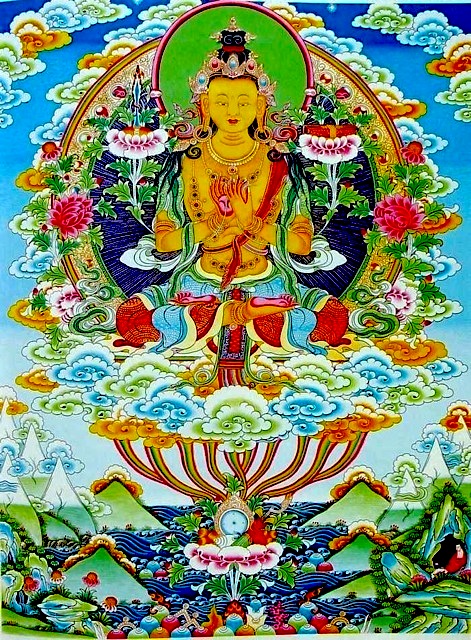
Maitreya Bodhisattva
Transcending Transcendence
My miraculous “sight seeing” trip with Dhyanyogi, and subsequent experiences, inspired ever increasing faith in his saintly good will and yogic powers. But questions arose for me about his Hindu path.
In writings introducing his path to Americans, Guruji said that Kundalini Maha Yoga was not a religion but a spiritual practice bringing “lasting inner peace and happiness to individuals of any belief or religious affiliation.” But his prescribed spiritual practices mostly included Sanskrit prayers and mantras associated with Hinduism, in addition to daily meditations.
At first I was uncomfortable reciting Sanskrit prayers and mantras which I didn’t understand, except for the Ram mantra with which I have always felt deep affinity. But intuitively I relied on Guruji’s extraordinary being and benevolence, and on his assurances that initiates would enjoy “a happy life”. So gradually I became more and more engaged in these practices, trusting that they would help me live a happy life.
Then, during a public meditation program, Guruji said these sanskrit practices would lead us to “the spiritual goal”. And I wondered: “what spiritual goal?” Amazingly, though I was still then an ‘uptight’ skeptical lawyer, I had taken an initiation from an unknown Hindu guru and was repeating his esoteric Sanskrit prayers and mantras not knowing what they meant or that their purpose was to achieve some “spiritual goal”.
So, after the meditation program, I asked others about this “spiritual goal”. I was told that the object of Hindu practices was to achieve “mukti” or “moksha” or “self-realization”; that the kundalini purification process, viz. the “evolutionary process taking place in [my] nervous system”, would some day in some lifetime lead to a state of Divine illumination where the Self, soul, or “Atman” would experience its Oneness with “Brahman” [Supreme Reality] – the pinnacle of human experience. Only then did I begin considering these ideas of “self realization”.
Though Guruji’s assurance of our finding lasting peace and happiness was appealing, I hadn’t consciously been drawn to him by this assurance but by a deep intuitive heartfelt connection. Before meeting Guruji I was not ‘goal oriented’. Instinctively hesitant to pursue materialistic societal goals, I was mostly inner – not outer – directed. But never before had I considered any inner ‘goals’.
In the late 1950’s I had been deeply influenced on reading “The Sane Society” by then prominent psychotherapist Erich Fromm, about the pathology of ‘normalcy’ in our materialistic society. Fromm suggested that Western society as a whole was lacking in sanity; that the inequities and disharmonies of the entire society were pathological, not just the mental illnesses of people therein. Fromm’s essay had confirmed and enhanced my instinctive reluctance to selfishly follow materialistic societal goals.
So, in becoming a lawyer and throughout my professional career, my main motivation was to help others; it was not to become rich or famous. Long before my spiritual awakening, I had a deep inner instinct to pursue social justice causes, with considerable sensitivity to the “insanity and iniquity of inequity in our society”.
But, with the Yosemite inner experience of “ten thousand suns” I realized that beyond my instinct for social justice was an extraordinarily intense longing for the Divine – to return from this crazy world back to God, back to Ram. However, not until hearing Dhyanyogi’s teachings about a spiritual “goal”, did I consider pro-actively seeking such an inner goal.
Though initially it seemed desirable to aspire to “self realization” or “enlightenment”, I was unable to relate experientially to those illumined states as ascribed to rare beings like Gautama Buddha. So, I was never clear about what to “seek” until, ultimately, I stopped seeking it, whatever it was.
After considerable reflection, I abandoned goal oriented spiritual seeking, and intuitively began with more and more heartfelt faith to surrender to the Infinite – “to let go, and go with the flow” – and to “leave it to the Lone Arranger.” * Perhaps, I transcended transcendence aspirations.
Inspired by the Buddhist Bodhisattva ideal of altruistically helping all beings end their sufferings, I stopped trying to be beyond this world, but rather to be in it in a way which might help all life everywhere. And I ceased regarding “enlightenment” as a “goal” but rather as an endless evolutionary process.
Experientially, I had realized that ‘the Kingdom of Heaven’, Buddha nature, and Love, were the Essence of everything in our phenomenal “reality”. And my core spiritual motivation became and remains:
“Infuse us, enthuse us, and use us, to bless all Life as LOVE.”
But paradoxically I have learned from experience that we cannot change others, only ourselves; that by furthering our own evolution we help elevate humanity’s common consciousness and thereby subtly help others. So, I consider it my responsibility to aspire to be the change I wish to see in the world, with the intention and dedication of so helping everyone everywhere.
And in this process, as Guruji promised, with unspeakable gratitude I am now enjoying “a happy life” beyond anything that I could have imagined when I received a shaktipat initiation in 1978.
*Footnote
Many ideas about “enlightenment” are in articles posted elsewhere on SillySutras.com. E.g. see https://sillysutras.com/?p=2925 and https://sillysutras.com/?p=1180
“The Gift of Giving”
~ a Synchronicity Story with Quotations
‘It is more blessed to give than to receive.’
~ Acts 20:35 (Paul quoting Jesus)
“The wise man does not lay up his own treasures.
The more he gives to others, the more he has for his own.”
~ Lao Tzu
“For in truth it is life that gives unto life –
while you, who deem yourself a giver,
is but a witness.”
~ Kahlil Gibran, The Prophet
“You can give without loving,
but you can never love without giving.”
~ Robert Louis Stevenson and/or
~ Victor Hugo, Les Misérables
“Lovers are givers, not getters.”
“Life is for giving, not getting.”
~ Ron Rattner, Sutra Sayings
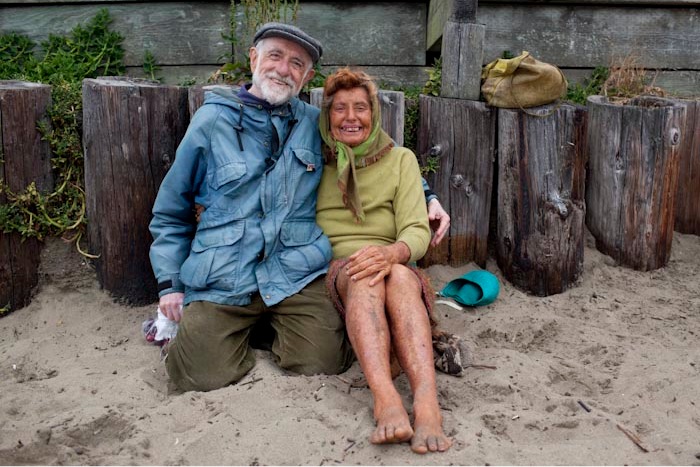
Ron Rattner and Carol Schuldt at Aquatic Beach, 2012
“The Gift of Giving”
Here is another amazing synchronicity story about my now 79 year old friend Carol Schuldt, one of the most unforgettable people I’ve ever known.
Carol is an extraordinarily intuitive free spirit, with her own unique path of communing with Nature while surfing, swimming, sunning, hiking, biking, and gardening, and helping troubled souls – especially young people. Though raised Catholic, she has never knowingly followed any prescribed Western or Eastern spiritual path. Because of her great generosity, especially toward needy young people, Carol is sometimes known as the “Mother Teresa of the Sunset District”.
We met long ago at Aquatic Beach on San Francisco Bay (across from Ghirardelli Square), where Carol often comes to escape ocean fog and swim in the sun. Since then, we’ve had innumerable synchronistic encounters and exchanged many “miracle” stories about our lives. [I’ve posted other synchronicity stories about Carol, which are linked below as “related posts”.]
As I write, I have just returned from another magical encounter with Carol at Aquatic Beach, on a cold December 29, where Carol shared with me a wonderful synchronicity story about her experiences earlier today and yesterday.
Here it is:
Carol swims or surfs in the ocean or Bay almost every day. But, on rare days when she can’t swim because of inclement or cold weather, Carol sometimes browses and shops at the main Goodwill resale store near downtown San Francisco.
Yesterday, was one of those rare days when it was too cold and rainy for Carol to swim. So she drove her old truck toward the Goodwill store, and parked several blocks away in front of a community garden on Fell Street. After walking to the Goodwill store and shopping, Carol was returning to her parked truck when suddenly she urgently needed to urinate. There were no available public restrooms, so she had to relieve herself in a nearby empty lot. Afterwards, to her chagrin and embarrassment, Carol discovered that she had mistakenly peed on an elderly homeless man’s tent.
In remorse, Carol opened the tent entry flap and apologized to its homeless occupant, telling him “I’m very sorry, but I just peed on your tent”. Then Carol pulled a twenty dollar bill out of her wallet, and tendered it to the homeless man, saying: “Here, please take this.” After looking at Carol (who is sometimes mistaken for a ‘street person’ or ‘bag lady’ because of her unusual attire and appearance) he replied: “No baby, I can’t take it.”
But Carol insisted he take the twenty dollar bill, emphatically repeating that she had just peed on his tent. So he relented, and took the money with a broad smile. Her guilty feelings assuaged, Carol then drove off in her old truck.
This morning it was again cold and inclement in San Francisco. So Carol decided to return again to the Goodwill store. As she again parked her old truck on Fell Street near the community garden, a small moving van stopped after its driver observed her. The driver got out of the van and offered to Carol the load he was transporting, asking her to take it onto her truck. On his van Carol saw many valuable garden tools and other artifacts in good condition which she could use in her organic garden, plus a new volley ball which her son Pete could use. So Carol accepted the van driver’s offer, and relieved him of responsibility to dispose of his load, by transferring it to her truck.
Thereupon, on seeing that the morning overcast was lifting to reveal patches of blue sky, Carol spontaneously decided to drive to Aquatic Beach instead of walking to the Goodwill store. At the beach, Carol swam in very cold water, then dressed and was sitting and warming herself in sunshine when a family group of tourists walked onto the beach and looked at her.
Jovially pointing at Carol, the family’s father exclaimed to his companions, “She’s having fun. There’s a happy person.” Then after walking to the shore with a child, he came back to Carol and offered her a twenty dollar bill. Carol – who is economically well off – told him “I can’t take that.” But he insisted. So Carol reluctantly accepted his twenty dollar gift.
Thus, just a day after she had spontaneously given a twenty dollar bill to a reluctant homeless man, Carol drove home from Aquatic Beach with another twenty dollar bill given her by a stranger after she reluctantly accepted it. And her old truck was filled with valuable garden equipment given to her by another stranger near the very same place where she peed on the homeless man’s tent.
Moral of this story:
“It is in giving that we receive.”
Laughter: Quotes and Hafiz poem
“When you realize how perfect everything is
you will tilt your head back and laugh at the sky.”
~ Buddha
“What is soap to the body, laughter is to the soul.”
~ Yiddish Proverb
“I would not exchange the laughter of my heart for the fortunes of the multitudes; nor would I be content with converting my tears, invited by my agonized self, into calm.
It is my fervent hope that my whole life on this earth will ever be tears and laughter.
Tears that purify my heart and reveal to me the secret of life and its mystery,
Laughter that brings me closer to my fellow men;
Tears with which I join the broken-hearted,
Laughter that symbolizes joy over my very existence.”
~ Kahlil Gibran
“Time spent laughing is time spent with the Gods.”
~ Japanese proverb
“Laughter is the shortest distance between two people.”
~ Victor Borg
“Sing because this is a food our starving world needs.
Laugh because that is the purest sound.”
~ Hafiz
“Blessed is he who makes his companions laugh.”
~ The Koran
“It is cheerful to God when you rejoice or laugh from the bottom of your heart.”
~ Martin Luther King Jr.
“I have been confronted with many difficulties throughout the course of my life, and my country is going through a critical period. But I laugh often, and my laughter is contagious. When people ask me how I find the strength to laugh now, I reply that I am a professional laugher.”
~ The Dalai Lama
Laughter ~ Hafiz
What is laughter? What is laughter?
It is God waking up! O it is God waking up!
It is the sun poking its sweet head out
From behind a cloud
You have been carrying too long,
Veiling your eyes and heart.
It is Light breaking ground for a great Structure
That is your Real body – called Truth.
It is happiness applauding itself and then taking flight
To embrace everyone and everything in this world.
Laughter is the polestar
Held in the sky by our Beloved,
Who eternally says,
“Yes, dear ones, come this way,
Come this way towards Me and Love!
Come with your tender mouths moving
And your beautiful tongues conducting songs
And with your movements – your magic movements
Of hands and feet and glands and cells – Dancing!
Know that to God’s Eye,
All movement is a Wondrous Language,
And Music – such exquisite, wild Music!”
O what is laughter, Hafiz?
What is this precious love and laughter
Budding in our hearts?
It is the glorious sound
Of a soul waking up!
Hafiz translation from: I Heard God Laughing – Renderings of Hafiz by Daniel Ladinsky
Think Before You Speak
“All that we are is the result of what we have thought:
it is founded on our thoughts, it is made up of our thoughts.
If a man speaks or acts with an evil thought, pain follows him,
as the wheel follows the foot of the ox that draws the carriage.”
~ Buddha
“A man is but the product of his thoughts; what he thinks, he becomes.”
~ Gandhi
“Nothing’s either good or bad, but thinking makes it so.”
~ Shakespeare
This world is wrought with naught but thought.
~ Ron Rattner, Sutra Sayings
The thought manifests as the word.
The word manifests as the deed.
The deed develops into the habit.
The habit hardens into the character.
The character gives birth to the destiny.
So, watch your thoughts with care
And let them spring from love
Born out of respect for all beings.
~ The Buddha, as paraphrased by Mahagosananda
Your Religion Is Not Important
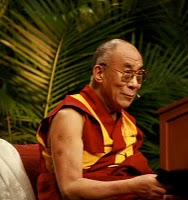
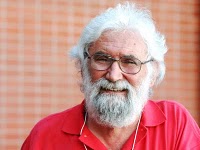
Introduction. The following is a brief dialogue between the Dalai Lama and Brazilian theologist Leonardo Boff, one of the renovators of the Theology of Freedom, as recounted by Boff:
Boff’s Narative.
“In a round table discussion about religion and freedom in which
Dalai Lama and myself were participating, at recess I maliciously, and also with interest, asked him:
“Your holiness, what is the best religion?”
“I thought he would say: “The Tibetan Buddhism” or “The oriental religions, much older than Christianity”
“Dalai Lama paused, smiled and looked me in the eyes ….which surprised me because I knew of the malice contained in my question. “He answered:
“The best religion is the one that gets you closest to God.
It is the one that makes you a better person.”
“To get out of my embarrassment with such a wise answer, I asked:
“What is it that makes me better?”
“He responded:
“Whatever makes you
more Compassionate,
more Sensible,
more Detached,
more Loving,
more Humanitarian,
more Responsible,
more Ethical.”
“The religion that will do that for you is the best religion”
“I was silent for a moment, marveling and even today
thinking of his wise and irrefutable response:
“I am not interested, my friend, about your religion
or if you are religious or not.
“What really is important to me is your behavior in
front of your peers, family, work, community,
and in front of the world.”
“Remember, the universe is the echo of our actions and our thoughts.
“The law of action and reaction is not exclusively for physics.
It is also of human relations.
If I act with goodness, I will receive goodness.
If I act with evil, I will get evil.
“What our grandparents told us is the pure truth.
You will always have what you desire for others.
Being happy is not a matter of destiny.
It is a matter of options.”
Finally he said:
“Take care of your Thoughts because they become Words.
Take care of your Words because they will become Actions.
Take care of your Actions because they will become Habits.
Take care of your Habits because they will form your Character.
Take care of your Character because it will form your Destiny,
and your Destiny will be your Life
… and …
“There is no religion higher than the Truth.”
You Tube presentation of this dialogue:
